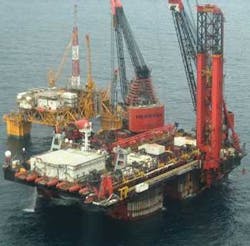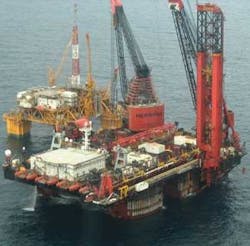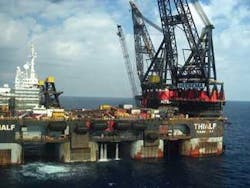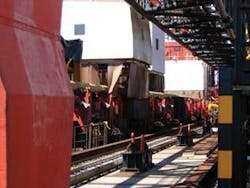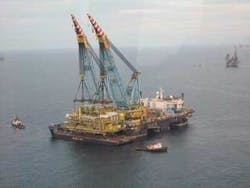Heavy-lift equipment active in Gulf of Mexico
Deepwater development calls for high-capacity construction and installation equipment. To meet those demands in the US Gulf of Mexico, two of Heerema Marine Contractors’ largest vessels are busy in the arena. Some of the recent work has included record-setting achievements. At the same time, Saipem also has set a lift record working for Pemex.
Work by Heerema’s dual crane vesselBalder at the semisubmersible production facility Independence Hub in Mississippi Canyon block 920 is racking up a long list of installation records. At the time of this writing, the Balder was installing record-length steel catenary risers (SCRs) to accommodate Independence Hub’s world record water depth of 2,438 m (8,000 ft). One reason Balder is at work on the Hub is that it has the largest capacity J-lay tower on any construction vessel, which enables it to lay pipe in deepwater. Next on the schedule is the export pipeline.
The platform also is the world’s largest in terms of production capacity, capable of handling up to 1 bcf/d of natural gas, which represents more than a 10% increase in current natural gas deliveries from the GoM and 2% of all US gas production. First gas is expected in 3Q 2007.
Gas will be exported through Enterprise’s 100% owned and operated Independence Trail pipeline to a platform in West Delta block 68, which is connected to shore via third-party pipeline.
The facility also has the record for the longest single umbilical ever ordered. Taken in total, Independence covers an area of 4,662 sq km (1,800 sq mi) and has 1,770 km (1,100 mi) of stainless steel tubing in its umbilicals.
Enterprise owns an 80% working interest inIndependence Hub; Helix Energy Solutions Group holds the remaining 20%. With the installation phase complete, control of the Independence Hubwill transfer to Anadarko Petroleum Corp. as platform operator for the group of producers developing the 10 fields discovered to-date.
HMC expects the heavy-lift vessel market will stay strong and that deeper water capacities will be required. Upgrades planned for theBalder will enable it to work in 3,658 m (12,000 ft) of water, says John Reed, HMC CEO.
EvenThialf, with the largest crane capacity in the world at 14,200 metric tons (15,653 tons), is in line for increased deepwater functions.Thialf is at work in Green Canyon on the pile installation for BHP on the Neptune TLP project. Water depth is about 1,310 m (4,300 ft). Piles had to be driven in advance to meet 60 day ‘’set up’’ requirements. The full platform is scheduled to be installed in May, also using Thialf.
HMC has announced plans to build a new deepwater semisubmersible construction vessel with at least two new features. It will be arctic-capable and will be designed for transit speeds of 18 knots. Currently, such vessels move at closer to 5 knots. This will make a major difference in the time required to move from one operating theater to another. Anticipated delivery date for the new vessel is 4Q 2010, Reed says.
In the nearer term, HMC is looking ahead to EPIC jobs in the Atlantic, particularly to take advantage of the new fabrication yard in the works for Nigeria, Reed says. That location will make heavy-lift and deepwater work in Angola, for instance, more convenient.
In the North Sea, in particular, Reed sees work coming in decommissioning old facilities. With heavy-lift capability, entire structures can be taken up and moved ashore for dismantling in a more controlled environment rather than having to be cut into smaller pieces on location to get them to shore for disposal. This is just the reverse of theThialf lifting fixed jacket structures into place rather than launching them. Reed says this installation method not only is more controlled, but saves time and money.
Looking even further into the future, Reed says Heerema is anticipating more work from national oil companies. HMC plans to establish a competitive presence in the Far East deepwater operation arenas.
In the Bay of Campeche, Saipem installed the Pemex BP-KU-A2 production platform deck using theSaipem 7000 in full DP mode. The reported lift weight of 9,521 metric tons (10,473 tons) set a new area record. Barged to the site, the deck was installed on the jacket in less than three hours, according to Saipem, with rig-up done offshore.
Independence Hub records
- World’s deepest subsea production tree at 2,743 m (9,000 ft) water depth
- World’s deepest flowline installation
- World’s deepest SCR installation
- World’s largest single subsea umbilical order
- World’s deepest export pipeline and SCR, originating in about 2,438 m (8,000 ft) of water
- World’s deepest platform in 2,438 m (8,000 ft) of water
- GoM’s largest gas processing facility at 1 bcf/d
- World’s longest mooring lines at 3.86 km (2.4 mi) each, and
- Deepest suction pile installation.
Prior to the current work of installing theIndependence Hub hull and topsides, the Balder pre-installed suction piles, 60 km (37 mi) of 203 mm (8 in.) flowlines and risers, and 11 subsea structures in water depths ranging from 2,377 to 2,682 m (7,800 to 8,800 ft).
